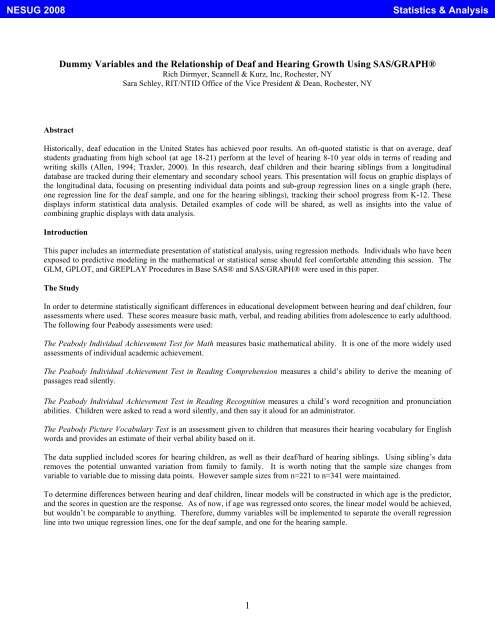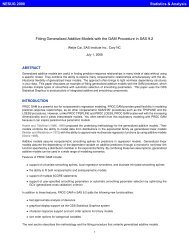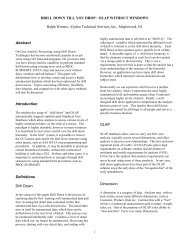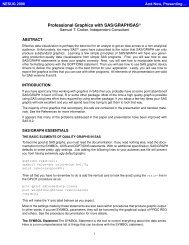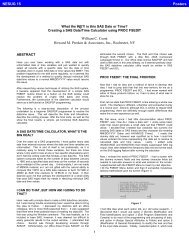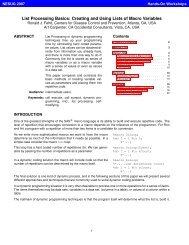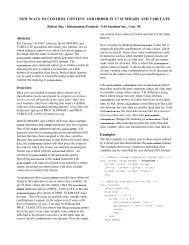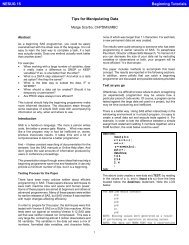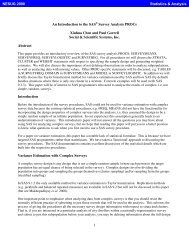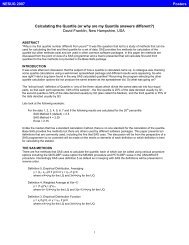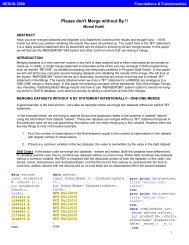Dummy Variables and the Relationship of Deaf and ... - NESUG
Dummy Variables and the Relationship of Deaf and ... - NESUG
Dummy Variables and the Relationship of Deaf and ... - NESUG
- No tags were found...
You also want an ePaper? Increase the reach of your titles
YUMPU automatically turns print PDFs into web optimized ePapers that Google loves.
<strong>NESUG</strong> 2008Statistics & Analysis<strong>Dummy</strong> <strong>Variables</strong> <strong>and</strong> <strong>the</strong> <strong>Relationship</strong> <strong>of</strong> <strong>Deaf</strong> <strong>and</strong> Hearing Growth Using SAS/GRAPH®Rich Dirmyer, Scannell & Kurz, Inc, Rochester, NYSara Schley, RIT/NTID Office <strong>of</strong> <strong>the</strong> Vice President & Dean, Rochester, NYAbstractHistorically, deaf education in <strong>the</strong> United States has achieved poor results. An <strong>of</strong>t-quoted statistic is that on average, deafstudents graduating from high school (at age 18-21) perform at <strong>the</strong> level <strong>of</strong> hearing 8-10 year olds in terms <strong>of</strong> reading <strong>and</strong>writing skills (Allen, 1994; Traxler, 2000). In this research, deaf children <strong>and</strong> <strong>the</strong>ir hearing siblings from a longitudinaldatabase are tracked during <strong>the</strong>ir elementary <strong>and</strong> secondary school years. This presentation will focus on graphic displays <strong>of</strong><strong>the</strong> longitudinal data, focusing on presenting individual data points <strong>and</strong> sub-group regression lines on a single graph (here,one regression line for <strong>the</strong> deaf sample, <strong>and</strong> one for <strong>the</strong> hearing siblings), tracking <strong>the</strong>ir school progress from K-12. Thesedisplays inform statistical data analysis. Detailed examples <strong>of</strong> code will be shared, as well as insights into <strong>the</strong> value <strong>of</strong>combining graphic displays with data analysis.IntroductionThis paper includes an intermediate presentation <strong>of</strong> statistical analysis, using regression methods. Individuals who have beenexposed to predictive modeling in <strong>the</strong> ma<strong>the</strong>matical or statistical sense should feel comfortable attending this session. TheGLM, GPLOT, <strong>and</strong> GREPLAY Procedures in Base SAS® <strong>and</strong> SAS/GRAPH® were used in this paper.The StudyIn order to determine statistically significant differences in educational development between hearing <strong>and</strong> deaf children, fourassessments where used. These scores measure basic math, verbal, <strong>and</strong> reading abilities from adolescence to early adulthood.The following four Peabody assessments were used:The Peabody Individual Achievement Test for Math measures basic ma<strong>the</strong>matical ability. It is one <strong>of</strong> <strong>the</strong> more widely usedassessments <strong>of</strong> individual academic achievement.The Peabody Individual Achievement Test in Reading Comprehension measures a child’s ability to derive <strong>the</strong> meaning <strong>of</strong>passages read silently.The Peabody Individual Achievement Test in Reading Recognition measures a child’s word recognition <strong>and</strong> pronunciationabilities. Children were asked to read a word silently, <strong>and</strong> <strong>the</strong>n say it aloud for an administrator.The Peabody Picture Vocabulary Test is an assessment given to children that measures <strong>the</strong>ir hearing vocabulary for Englishwords <strong>and</strong> provides an estimate <strong>of</strong> <strong>the</strong>ir verbal ability based on it.The data supplied included scores for hearing children, as well as <strong>the</strong>ir deaf/hard <strong>of</strong> hearing siblings. Using sibling’s dataremoves <strong>the</strong> potential unwanted variation from family to family. It is worth noting that <strong>the</strong> sample size changes fromvariable to variable due to missing data points. However sample sizes from n=221 to n=341 were maintained.To determine differences between hearing <strong>and</strong> deaf children, linear models will be constructed in which age is <strong>the</strong> predictor,<strong>and</strong> <strong>the</strong> scores in question are <strong>the</strong> response. As <strong>of</strong> now, if age was regressed onto scores, <strong>the</strong> linear model would be achieved,but wouldn’t be comparable to anything. Therefore, dummy variables will be implemented to separate <strong>the</strong> overall regressionline into two unique regression lines, one for <strong>the</strong> deaf sample, <strong>and</strong> one for <strong>the</strong> hearing sample.1
<strong>NESUG</strong> 2008Statistics & AnalysisMethod <strong>of</strong> AnalysisSometimes in statistics, variables have two or more distinct levels, such as machines or operators. Often times <strong>the</strong>sevariables are referred to as categorical variables. In order to properly analyze <strong>the</strong> data using <strong>the</strong>se types <strong>of</strong> variables, onemust take into account <strong>the</strong> fact that variables with multiple levels may have separate deterministic effects on <strong>the</strong> responsevariable. In situations like this, <strong>the</strong> implementation <strong>of</strong> dummy variables is highly useful.There are many ways to set up dummy variables so long as <strong>the</strong>y are linearly independent <strong>of</strong> o<strong>the</strong>r variables in <strong>the</strong> model. Theparticular set up used in this research codes deaf = 1 <strong>and</strong> hearing = 0. It should be said that a variable with a levels willemploy <strong>the</strong> use <strong>of</strong> a-1 dummy variables. Since <strong>the</strong> study only concerns deaf <strong>and</strong> hearing siblings, only one dummy variableis necessary.As stated before, only one dummy variable was needed. The general model that will be constructed takes on <strong>the</strong> form:Y (o 1 0 1X= β + β X ) + Z ( α + α ) + εIn <strong>the</strong> model Z represents <strong>the</strong> dummy variable, <strong>and</strong> it can be seen that if Z=0 <strong>the</strong> hearing model becomes:<strong>and</strong> when Z=1 <strong>the</strong> deaf model becomes:Y = β + X 10βY = β + α ) + ( β + )X(0 0 1α1Now with two regression models, differences between <strong>the</strong> deaf <strong>and</strong> hearing samples can be tested. It is easy enough to show<strong>the</strong> two samples are in fact different yet something else may be shown. A difference only concludes that <strong>the</strong>re are tworegression lines present, but does not show how <strong>the</strong> lines differ from one ano<strong>the</strong>r. Four situations arise:Situation 1: Two distinct regression models with different slopes, <strong>and</strong> different intercepts (4 parameters).Situation 2: Two distinct regression models with equal slopes, <strong>and</strong> different intercepts (3 parameters).Situation 3: Two distinct regression models with different slopes, <strong>and</strong> equal intercepts (3 parameters).Situation 4: One distinct regression line with equal slopes <strong>and</strong> equal intercepts (2 parameters).Identifying one <strong>of</strong> <strong>the</strong>se situations gives even more information than a simple difference between <strong>the</strong> two samples. Thesesituations tell us whe<strong>the</strong>r or not deaf <strong>and</strong> hearing siblings begin at <strong>the</strong> same levels, or different levels, <strong>and</strong> whe<strong>the</strong>r or not <strong>the</strong>yprogress at <strong>the</strong> same, or a different rate. As an aid to <strong>the</strong> analysis performed on <strong>the</strong> data, scatter plots have been provided.AnalysisIn order to test each situation, <strong>the</strong> appropriate F-tests must be constructed using extra sums <strong>of</strong> squares (ESS). The ESS aresimply calculated as:ESSTest Parameter= SSRe gression− SSParametersnot testedThat is, <strong>the</strong> extra sums <strong>of</strong> squares that are produced by <strong>the</strong> addition <strong>of</strong> <strong>the</strong> respective test parameters. Once <strong>the</strong> ESS areobtained, <strong>the</strong> formal F-test may be performed as in any ANOVA or regression analysis.Fortunately, SAS produces tests based on <strong>the</strong>se ESS, which it calls Type III Sums <strong>of</strong> Squares. The trick in obtaining <strong>the</strong>Type III SS for a regression model involves using The GLM Procedure. The following code was used to obtain <strong>the</strong> necessarytests for deciding which situation is present:2
<strong>NESUG</strong> 2008Statistics & AnalysisData RichD.Dualsample;input age deaf_flag ;interaction = age*deaf_hear;Run;Proc Glm Data=RichD.Dualsample;model = age deaf_flag interaction / SS3;Run;The lack <strong>of</strong> <strong>the</strong> CLASS statement in PROC GLM treats each independent variable in <strong>the</strong> model as one degree <strong>of</strong> freedom,essentially fitting a regression model ra<strong>the</strong>r than an additive model. The SS3 option in <strong>the</strong> model statement suppresses <strong>the</strong>Type I Sums <strong>of</strong> Squares <strong>and</strong> produces <strong>the</strong> ESS needed to draw conclusions. Example output resulting from <strong>the</strong> code lookslike:Sum <strong>of</strong>Source DF Squares Mean Square F Value Pr > FModel 3 42005.30802 14001.76934 88.55 Fage 1 25495.25056 25495.25056 161.23
<strong>NESUG</strong> 2008Statistics & AnalysisGoptions Reset=All Device=GIF;Symbol1 Color=Blue Interpol=None Value=Circle Height=1 Width=1;Symbol2 Color=Red Interpol=None Value=Square Height=1 Width=1;Axis1 Order=(0 to 20 by 1)Label=(Color=black Height=2 'Age')Major=(Height=1) Minor=NoneWidth=2;Axis2 Order=(0 to n by i)Label=(Color=black Angle=90 Height=2 'Name <strong>of</strong> Test')Major=(Height=1) Minor=NoneWidth=2;Legend1 Label=(Color=Black Height=2 'Population')Value=(Color=Blue Height=2 '<strong>Deaf</strong>' 'Hearing')Across=1 Down=2Position=(Top Left Inside)Mode=Share;Since <strong>the</strong> graphs produced were treated as static graphs, <strong>the</strong>y were stored as GIF files using <strong>the</strong> DEVICE= option whichprovide no opportunity for interactivity, <strong>and</strong> take up minimal space. Two SYMBOL statements were used in order todistinguish between <strong>the</strong> deaf <strong>and</strong> hearing sample. Colors, as well as shapes were used using <strong>the</strong> COLOR= <strong>and</strong> VALUE=options respectively to represent each sample as first a visual pleaser, <strong>and</strong> <strong>the</strong>n in <strong>the</strong> event <strong>of</strong> <strong>the</strong> document printed in black<strong>and</strong> white, visual separation.Axes were <strong>the</strong>n set using appropriate scales. The only assessment which does not follow <strong>the</strong> same scaling in scores is <strong>the</strong>Peabody Picture Vocabulary Test, so <strong>the</strong> only modification necessary in <strong>the</strong> above code is <strong>the</strong> ORDER= option <strong>of</strong> <strong>the</strong> y-axis.Also, in <strong>the</strong> AXES2 statement, <strong>the</strong> label was rotated 90 degrees using <strong>the</strong> ANGLE= option in order to keep <strong>the</strong> graphs cleanlooking <strong>and</strong> compact.Lastly, a legend was created which was given <strong>the</strong> dimension 2 x 1 using <strong>the</strong> ACROSS= <strong>and</strong> DOWN= options, <strong>and</strong> positionedin <strong>the</strong> upper left corner <strong>of</strong> <strong>the</strong> graph, with MODE=share specified. This last option ensures that <strong>the</strong> legend does not cover anydata points which may impede <strong>the</strong> space where <strong>the</strong> legend was positioned.Now, with <strong>the</strong> appropriate options specified, The GPLOT procedure was run.Proc GPlot Data=RichD.DualPlot;Plot *deaf_age *hearing_age /Overlay Legend=Legend1NoFrameHaxis=axis1Vaxis=axis2;Quit;In order to visually detect which situation is present, both populations were plotted on <strong>the</strong> same graphing window using <strong>the</strong>overlay option. Lastly, The GREPLAY procedure was used to condense <strong>the</strong> four graphs into one window.Proc GReplay igout=work.gseg tc=sashelp.templt template=L2R2 n<strong>of</strong>s;Treplay 1:gplot 2:gplot1 3:gplot2 4:gplot3;Quit;4
<strong>NESUG</strong> 2008Statistics & AnalysisAs each graph is created in PROC GPLOT, it is stored in <strong>the</strong> work.gseg directory, with naming conventions related to <strong>the</strong>creation order <strong>of</strong> each graph. PROC GREPLAY allows users to augment graphs into matrix plots if desirable, giving usersnumerous templates to choose from, which are located in <strong>the</strong> sashelp.templt directory. The template chosen for this paper is<strong>the</strong> L2R2 template, which intuitively creates a square 2 x 2 matrix plot. Using <strong>the</strong> TREPLAY statement determines <strong>the</strong>placement <strong>of</strong> <strong>the</strong> specified graphs, <strong>and</strong> as a result, <strong>the</strong> following matrix plot is obtained.Popul at i on<strong>Deaf</strong>Heari ngPopul at i on<strong>Deaf</strong>Heari ngAgeAgePopul at i on<strong>Deaf</strong>Heari ngPopul at i on<strong>Deaf</strong>Heari ngAgeAgeAs a recap, <strong>the</strong> graph displaying <strong>the</strong> PIAT Math scores shows that <strong>the</strong>re are in fact two distinct regression models, withdifferent slopes <strong>and</strong> same intercepts. Therefore, among deaf <strong>and</strong> hearing siblings, both start <strong>of</strong>f at <strong>the</strong> same level regardingma<strong>the</strong>matical ability, however hearing siblings develop <strong>the</strong>ir math skills at a quicker rate than <strong>the</strong>ir deaf siblings. Regarding,<strong>the</strong> Peabody Picture Vocabulary Test, <strong>the</strong>re are two distinct regression models, <strong>and</strong> <strong>the</strong> deaf <strong>and</strong> hearing siblings progress at<strong>the</strong> same rate, yet begin at different levels. As for <strong>the</strong> PIAT in Reading Recognition, <strong>the</strong>re are two distinct regression modelswith different slopes <strong>and</strong> different intercepts. Graphically, it appears that <strong>the</strong> hearing sample starts <strong>of</strong>f at a higher level, <strong>and</strong>progresses at a quicker rate. Lastly, <strong>the</strong> PIAT in Reading Comprehension shows <strong>the</strong> same situation as <strong>the</strong> recognition testing,however in this case, <strong>the</strong> deaf sample begins at a higher level than <strong>the</strong> hearing sample.ConclusionThis study revealed interesting points about <strong>the</strong> relationship between deaf <strong>and</strong> hearing development. The use <strong>of</strong> <strong>the</strong> SASsystem’s graphing <strong>and</strong> regression capabilities gives users a new approach to classic regression problems. The GPLOTprocedure allows users to interpret <strong>the</strong> statistical conclusions in a concise manner with supporting visuals. While <strong>the</strong> datadoes not indicate that high school deaf children perform at a level <strong>of</strong> 8-10 year olds, <strong>the</strong> deaf sample scores did increase at aslower rate than <strong>the</strong> hearing sample in each <strong>of</strong> <strong>the</strong> four assessments.5
<strong>NESUG</strong> 2008Statistics & AnalysisReferencesTraxler, Carol Bloomquist. 2000 Fall. “The Stanford Achievement Test, 9 th Edition: National Norming <strong>and</strong> PerformanceSt<strong>and</strong>ards for <strong>Deaf</strong> <strong>and</strong> Hard-<strong>of</strong>-Hearing Students”. Journal <strong>of</strong> <strong>Deaf</strong> Studies <strong>and</strong> <strong>Deaf</strong> Education. 5(4): 337-348.Bureau <strong>of</strong> Labor Statistics. “National Longitudinal Surveys”. http://www.bls.gov/nlsSAS® <strong>and</strong> all o<strong>the</strong>r SAS Institute Inc. product or service names are registered trademarks or trademarks <strong>of</strong> SAS Institute Inc,in <strong>the</strong> USA <strong>and</strong> o<strong>the</strong>r countries. ® indicates USA registration.AcknowledgementsSAS <strong>and</strong> all o<strong>the</strong>r SAS Institute Inc. product or service names are registered trademarks <strong>of</strong> SAS Institute Inc, in <strong>the</strong> USA <strong>and</strong>o<strong>the</strong>r countries. ® indicates USA registration.The research outlined in this document was supported by NSF Career Award #REC0346951 – “<strong>Deaf</strong> Children <strong>and</strong> YoungAdults: Predicting School, College <strong>and</strong> Labor Success.”Special thanks to:The individuals <strong>of</strong> Scannell & Kurz, Inc. <strong>and</strong> <strong>the</strong>ir endless support <strong>of</strong> <strong>the</strong>ir employees.My beautiful wife Roselle Dirmyer, <strong>and</strong> her endless support <strong>of</strong> my research <strong>and</strong> career objectives.Contact InformationRich DirmyerScannell & Kurz, Inc.71-B Monroe AvenuePittsford, NY 14534Work Phone: 585-381-1120E-mail: dirmyer@scannellkurz.comSara SchleyRIT/NTID Office <strong>of</strong> <strong>the</strong> Vice President & Dean52 Lomb Memorial DriveRochester, NY 14623Work Phone: 585-475-7981E-mail: sara.schley@rit.edu6


